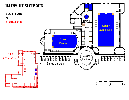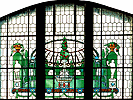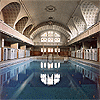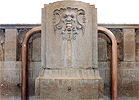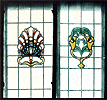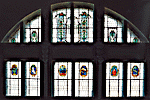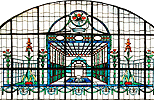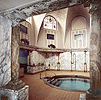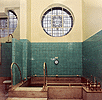Located in the new districts of Strasbourg
(1), the City Public Baths
(2) hide behind their name a genuine
temple dedicated to hydrotherapy.
The main
building (inaugurated in august 1908) hosts (among else) two pools as well as roman baths.
Under the cupola
Let's climb the stair that spans a fence to enter an elliptic rotunda. Two bathers are welcoming you down from their pedestal.
The eyes are catched first by a colonnade (with a marbled decor) sustaining a
cupola. Are we in a temple? Maybe, if one's means that here hygiene is worshipped by the way of ablution rituals. Several cartouches dedicated to water confirm the purpose of the premises.
Go to the pay-desk
Two swimming pools are located around the reception area, in accordance to custom, to separate gentlemen from ladies.
Ladies first
Let's begin with the
small pool: (57x31 ft) like in a nave, it is covered by a vault-ceiling adorned with stuccos and putti, and ends with a
half cupola, the latter following the curve that closes the pool. The other end of the latter gets a stoup-shaped
fountain adorned with golden mosaics.
Up to men level (sorry, women level), prussian blue tiles give a dark echo to the pool's azure where stained glass windows are mirrored. The latters, drawn by E. Fettig, an co-worker of Beblo, and offer in some cases a classic pattern, while others are definitely art nouveau, or even in some cases show an abstact design.
Even the staircase is lit by a stained glass
windows.
Finally, at the upper level, a huge stained glass
window offers a sound touch of beauty to the group.
For Gentlemen
The
big pool (80x39 ft) stretches out between two rows of wooden cubicles, begins with a fountain adorned with a
mascaron accompanied with shells and golden
mosaics.
This space is covered with a vault-shaped ceiling which has a structure made of reinforced concrete and is covered by a second vault, in order to give a better thermal insulation.
The whole area it lit by stained glass windows. In a background filled with ocre tiles and brass showers, we can find again art nouveau stained glass
windows, meanwhile the gallery is lit by some with either
historicist, or geometric, or
art nouveau patterns.
At that time, nothing was too beautiful for swimmers, nevertheless the best is to come...
The roman baths
Formerly called irish-russian-roman
baths, they represent now the largest and most beautiful unit existing in France.
Entering between two rows of wooden alcoves, you are invited to jump into your birthday's suit before to go to the steam room (45°C). Some steps guessed through the fog suggest you to take place. In a corner, a fountain dispenses its lapping. On the wall, a strange brass device allows you to spray yourself with steam, giving you a ghostly appearance. Now, that you are moistened, you are ready to enter the dry-steam room (60°C) where beds made of teak wood are awaiting you. Nearing your melting point, you stoically enter the small vaulted room at 75°C, lit by a circular stained glass
window. Wavering between the armchair and a bed, you wan't miss to read the notice reminding you to stay between 5 and 10 mn (will you?). Not far from your boiling point, you rush to the shower room, the center in the circuit of your ablutions.
This
room deserves your attention. Calacatta marble on the walls, Lunel stone for the pool, original brass taps. Sit down in the pool (the water is in 34°C) and give a glance to the ceiling with rib vaults and stained glass windows, the latter showing either an abstract or an art nouveau pattern.
Now you are ready for a massage followed by a walk in the cold bath (21°C), then in the
Wildbad, just the time to look at the stained glass
windows influenced by japanese art and signed Ehrismann.
Let's go to do it again? According to your mood, you may follow either the course you prefer, or the red line painted on the floor.
If you feel like it, some deck-chairs await you on the upper gallery whose ceiling is lit by eclectic stained glass windows. While climbing the stair, don't miss to look at the
hand rail, which is similar to another one by Beblo, in the nowadays
Annexe of the
Ecole des Arts Décos (1908-1910). Don't also forget to give a glance to the large stained glass window that lits the staircase.
There is not any part of the decor that has been neglected by Beblo, so trivial it may be, like, for instance, that door
latch.
The medicinal baths
To the facilities dedicated to hygiene has been added (from 1908 to 1910) a side
wing formerly intended for hydrotherapy.
In this way, one's could find installations for mecanotherapy, electrotherapy (electric bath), fangotherapy (sludge baths), phototherapy, swedish movements, sulfur baths, an inhalatorium, and a dental school. From all those
equipments, few remains. But we must notice the existence of stained glass
windows, which, for some of those, figur the very beginnings of the
Art Déco style.
In order to be complete, we must mention that, at the beginning, the City Public Baths were also offering the services of a solarium and a dog bath (the
entrance of the latter still exists).
As a conclusion, the best we could say it come there to visit and to use the premises whose charming decor is equal to none in France.
(1) In 1922, only 21 baths (with swimming pools) -among them 7 in Paris- were existing in France, meanwhile 880 in UK, and more than 1300 in Germany.
(2) It is necessary to remember that at this time, baths were built for hygienic needs, rather than for relaxation or sports. Running water did not exist in every house at Strasbourg, and bathtubs were (in 1914) mostly for the bourgeoisie.
Bibliography
- DERNIERES NOUVELLES D'ALSACE Les Bains classés, Strasbourg, 28 juin 2000.
- DERNIERES NOUVELLES D'ALSACE Baignade du temps jadis, Strasbourg, 2 juillet 2000.
- DERNIERES NOUVELLES D'ALSACE Les bains à l'inventaire, Strasbourg, 22 novembre 2000.
- FRANCK E. Städtisches Schwimm- und Medizinalbad in Straßburg i. E., in Bauzeitung für Württemberg·Baden·Hessen·Elsass-Lothringen, Stuttgart, V. Jahrgang, 1908, 41, pp. 325-328.
- HARSTER D. Les bains municipaux de Strasbourg: un établissement exemplaire de la "Belle Epoque", Dossier IVSMH.
- KRENCKER D., KRÜGER E., LEHMANN H., WACHTLER H. Trierer Grabungen und Forschungen, Band I,1: Die Trierer Kaiserthermen, Abteilung I, pp. 300 & 328, Augsburg, 1929.
- MEYZAUD J. Langueurs de bains, in Les Saisons d'Alsace, pp.96-101, 8, automne 2000.
- PERILLON M.-C. Les Bains, quelle classe!, in Strasbourg Magazine, pp. 32-33, 118, février 2001.
- ROETHINGER J. Le bain romain, in Le Courrier de Schiltigheim, 10e année, no37, Schitigheim, septembre 1975.
- ZOPPAS L. Les Bains, Mémoire de T.P.F.E., Strasbourg, 1997

